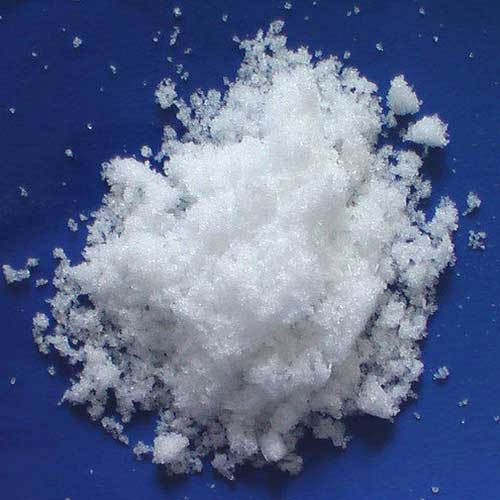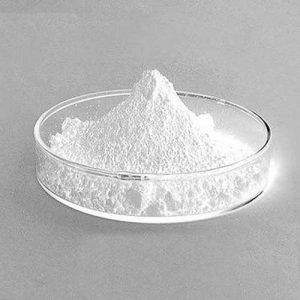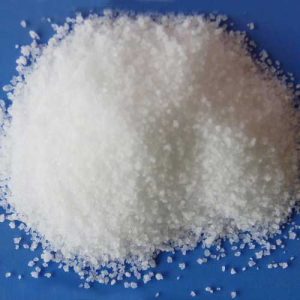- Have any questions?
- 91-22-23726950
- 91-22-23774610

Selenious acid
May 7, 2019
Sodium Bicarbonate
May 7, 2019Sodium Acetate
Muby Chemicals established in the year 1976, is pioneer in Manufacturing Chemicals for Oil and Gas Exploration, Hydraulic Fracturing (Fracking) and coiled tube Chemicals.Our advanced chemistry leading to an innovative and high-performance product range is coupled with effective on and off site management services.
We are manufacturer of Specialty chemicals, Pharmaceutical Excipients, Fragrance & Flavorchemicals in India, which are of IP, BP, USP, Ph. Eur., FCC or Food Grade, ACS, AR or Analytical Reagent Grade, LR or Laboratory Reagent Grade, Pure and Technical Grades of various chemicals.
Sodium Acetate USP Specifications
Sodium Acetate USP
C2H3NaO2-3H2O 136.08
Assay— Sodium Acetate contains three molecules of water of hydration, or is anhydrous. It contains not less than 99.0 percent and not more than 101.0 percent of C2H3NaO2, calculated on the dried basis.
Packaging and storage— Preserve in tight containers.
Labeling— Label it to indicate whether it is the trihydrate or is anhydrous. Where Sodium Acetate is intended for use in hem dialysis, it is so labeled.
Identification— A solution responds to the test for Sodium and for Acetate.
pH: between 7.5 and 9.2, in a solution in carbon dioxide-free water containing the equivalent of 30 mg of anhydrous sodium acetate per mL.
Loss on drying— Dry at 120 to constant weight: the hydrous form loses between 38.0% and 41.0% of its weight, and the anhydrous form loses not more than 1.0% of its weight.
Insoluble matter— Dissolve the equivalent of 20 g of anhydrous sodium acetate in 150 mL of water, heat to boiling, and digest in a covered beaker on a steam bath for 1 hour. Filter through a tarred filtering crucible, wash thoroughly, and dry at 105 : the weight of the residue does not exceed 10 mg (0.05%).
Chloride— A portion equivalent to 1.0 g of anhydrous sodium acetate shows no more chloride than corresponds to 0.50 mL of 0.020 N hydrochloric acid (0.035%).
Sulfate— A portion equivalent to 10 g of anhydrous sodium acetate shows no more sulfate than corresponds to 0.50 mL of 0.020 N sulfuric acid (0.005%).
Calcium and magnesium— To 20 mL of a solution containing the equivalent of 10 mg of anhydrous sodium acetate per mL add 2 mL each of 6 N ammonium hydroxide, ammonium oxalate TS, and dibasic sodium phosphate TS: no turbidity is produced within 5 minutes.
Potassium— Dissolve the equivalent of 3 g of anhydrous sodium acetate in 5 mL of water, add 1N acetic acid drop wise until the solution is slightly acidic, and then add 5 drops of sodium cobalt nitrite TS: no precipitate is formed.
Aluminum: (where it is labeled as intended for use in hem dialysis)— the limit is 0.2µ =g per g.
Heavy metals—the limit is 0.001%.
Organic volatile impurities: meets the requirements.
Sodium Acetate Trihydrate BP Specifications
Sodium Acetate BP
C2H3NaO2,3H2O
Action and use
Used in solutions for dialysis; excipient.
DEFINITION
Sodium ethanoate trihydrate.
Content
99.0 per cent to 101.0 per cent (dried substance).
CHARACTERS
Appearance
Colourless crystals.
Solubility
Very soluble in water, soluble in ethanol (96 per cent).
IDENTIFICATION
A. 1 ml of solution S (see Tests) gives reaction (b) of acetates.
B. 1 ml of solution S gives reaction (a) of sodium.
C. Loss on drying (As shown in the Relevant Test).
TESTS
Solution S
Dissolve 10.0 g in carbon dioxide-free water prepared from distilled water R and dilute to 100 ml 100 ml with the same solvent.
Appearance of solution
Solution S is clear and colourless.
pH
7.5 to 9.0.
Dilute 5 ml of solution S to 10 ml with carbon dioxide-free water.
Reducing substances
Dissolve 5.0 g in 50 ml of water, then add 5 ml of dilute sulphuric acid and 0.5 ml of 0.002 M potassium permanganate. The pink colour persists for at least 1 h. Prepare a blank in the same manner but without the substance to be examined.
Chlorides
Maximum 200 ppm.
Sulphates
Maximum 200 ppm.
Aluminium
Maximum 0.2 ppm, if intended for use in the manufacture of dialysis solutions.
Arsenic
Maximum 2 ppm, determined on 0.5 g.
Calcium and magnesium
Maximum 50 ppm, calculated as Ca.
Heavy metals
Maximum 10 ppm.
Iron
Maximum 10 ppm, determined on 10 ml of solution S.
Loss on drying
39.0 per cent to 40.5 per cent, determined on 1.000 g by drying in an oven at 130C.
Sodium Acetate FCC Food Grade, US Food Chemical Codex
C2H3NaO2 Formula wt, anhydrous 82.03
C2H3NaO2·3H2O Formula wt, trihydrate 136.08
DESCRIPTION
Sodium Acetate occurs as colorless, transparent crystals or as a granular, crystalline or white powder. The anhydrous form is hygroscopic; the trihydrate effloresces in warm, dry air. One gram of the anhydrous form dissolves in about 2 mL of water; 1 g of the trihydrate dissolves in about 0.8 mL of water and in about 19 mL of alcohol.
Function: Buffer.
REQUIREMENTS
Identification: A 1:20 aqueous solution gives positive tests for Sodium and for Acetate.
Assay: Not less than 99.0% and not more than 101.0% of C2H3NaO2 after drying.
Alkalinity Anhydrous: Not more than 0.2%; Trihydrate: Not more than 0.05%.
Lead: Not more than 2 mg/kg.
Loss on Drying: Anhydrous: Not more than 1.0%; Trihydrate: Between 36.0% and 41.0%.
Potassium Compounds: Passes test.
Sodium Acetate Anhydrous ACS Analytical Reagent specifications
American Chemical Society Reagent Grade
Sodium Acetate Anhydrous
CH3COONa
Formula Wt 82.03
CAS Number 127-09-3
REQUIREMENTS
Assay: 99.0% C2H3O2Na
pH of a 5% solution: 7.0-9.2 at 25C
MAXIMUM ALLOWABLE
Insoluble matter: 0.01%
Loss on drying at 120C: 1.0%
Chloride (Cl): 0.002%
Phosphate (PO4): 0.001%
Sulfate (SO4): 0.003%
Calcium (Ca): 0.005%
Magnesium (Mg): 0.002%
Heavy metals (as Pb): 0.001%
Iron (Fe): 0.001%
Sodium Acetate Trihydrate ACS Analytical Reagent specifications
American Chemical Society Reagent Grade
NaC2H3O2 . 3H2O
Formula Wt 136.08
CAS Number 6131-90-4
REQUIREMENTS
Assay: 99.0-101% NaC2H3O2 . 3H2O
pH of a 5% solution: 7.5-9.2 at 25C
Substances reducing permanganate: Passes test
MAXIMUM ALLOWABLE
Insoluble matter: 0.005%
Chloride (Cl): 0.001%
Phosphate (PO4): 5 ppm
Sulfate (SO4): 0.002%
Heavy metals (as Pb): 5 ppm
Iron (Fe): 5 ppm
Calcium (Ca): 0.005%
Magnesium (Mg): 0.002%
Potassium (K): 0.005%




